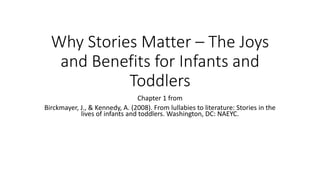Why stories matter – the joys and benefits
•Als PPTX, PDF herunterladen•
0 gefällt mir•341 views
Stories are important for infants and toddlers for several reasons: - Stories help develop language skills, relationships, and understanding of the world. They support communication, literacy, and concept development. - Developmentally appropriate stories can be told or read, involve pictures, rhymes, or the child's interests, and don't need complex plots. - Telling stories in everyday interactions, songs, play, and books helps children's cognitive and language development while strengthening relationships.
Melden
Teilen
Melden
Teilen

Empfohlen
Empfohlen
Weitere ähnliche Inhalte
Was ist angesagt?
Was ist angesagt? (18)
Learning theories supporting early literacy development

Learning theories supporting early literacy development
A Wealth of Words: Building Language, Literacy, Culture and Community in Earl...

A Wealth of Words: Building Language, Literacy, Culture and Community in Earl...
Every Child Ready to Read @ LCPL--a Brief Introduction

Every Child Ready to Read @ LCPL--a Brief Introduction
Andere mochten auch
Andere mochten auch (18)
Chapter 16 facilitating speech, language, and communication skills

Chapter 16 facilitating speech, language, and communication skills
Ähnlich wie Why stories matter – the joys and benefits
Ähnlich wie Why stories matter – the joys and benefits (20)
Parent Literacy Childhood Education Kaleena Springsteen.docx

Parent Literacy Childhood Education Kaleena Springsteen.docx
Building-and-Enhancing-Literacy-Skills-Across-the-Curriculum.pptx

Building-and-Enhancing-Literacy-Skills-Across-the-Curriculum.pptx
Teaching storytelling through varied learning styles big books (1)

Teaching storytelling through varied learning styles big books (1)
Phac facilitating child lang developmt ahs revised final compr

Phac facilitating child lang developmt ahs revised final compr
CE320Language Development in the Young ChildUnit 5.docx

CE320Language Development in the Young ChildUnit 5.docx
Mehr von blantoncd
Mehr von blantoncd (19)
Education purpose, organization, governance, and funding

Education purpose, organization, governance, and funding
Why stories matter – the joys and benefits
- 1. Why Stories Matter – The Joys and Benefits for Infants and Toddlers Chapter 1 from Birckmayer, J., & Kennedy, A. (2008). From lullabies to literature: Stories in the lives of infants and toddlers. Washington, DC: NAEYC.
- 2. Objectives • Identify the basic components of language and cognitive processes in developing curriculum activities • Identify and plan developmentally appropriate curriculum activities for infants and toddlers that enhance language and cognitive development.
- 3. The Role of Stories Across Domains • Stories help develop healthy attachment and relationships with infants and toddlers • They provide language skills for communication and future reading and writing (literacy) skills • Stories help children understand the world around them through concept development, vocabulary, and positive interactions
- 4. What Constitutes a Story? • “events plus emotion” (p. 2) • Stories may be told or read • More involved stories may have the components of beginning, middle, and end with characters, plots and settings, but those may not be appropriate for infants and toddlers. • Stories may be rhythmic in nature such as poems, songs and chants. • They may be formal or informal • For our purposes, stories encompass all the early language experiences in which we engage the infants and toddlers in our care
- 5. Identifying Developmentally Appropriate Stories • Pictures are important for storytelling, whether stories are oral or have text • Example: Family pictures at the infant or toddler’s eye level allow for many spontaneous stories about the baby’s family. • Simple rhymes and knee games promote language development and strengthen relationships • Example: Simple rhymes for younger babies. More complex rhymes can be introduced for older toddlers. • Books, pictures, stories that interest babies and toddlers • Example: Many babies love books with simple objects they begin to identify as they gain skills. Toddlers may have a favorite book they want to hear over and over.
- 6. How Do We Offer Stories? • There is a wonderful chart on p. 4 of your text that describes a variety of ways in which we share stories. Some examples include: • Everyday conversations • Singing songs • Oral traditions • Writing the stories they tell you • Encouraging dramatic play with props that support their play and interests • Providing a variety of books for the children to use independently • Reading with children • Allowing children to talk about the pictures they see in a book. Older toddlers may even create their own story to go with the pictures.
- 7. Language and Cognitive Enrichment through Stories • There are many suggestions for how stories enrich the lives of young children on pp. 4 & 5 in your text. • Can you provide an example of each of these suggestions that you have experienced with a young child? • Can you add anything to the list of ways in which story telling has enhanced and enriched the lives of the infants and toddlers in your care? • Which of the suggestions do you think is most important and why? • Which is the most difficult to do regularly and why?
- 8. Strengthening Relationships • Healthy attachments and bonding are crucial in positive development in all an infant’s developmental domains • Read the many positive impacts that sharing stories with infants and toddlers has on healthy relationships (pp. 6 & 7) • Can you add others?
- 9. Telling Stories Promotes Literacy Development • Literacy is “language in use”. • Literacy is social and reflects a community’s culture, values and beliefs. • Literacy promotes communication skills, both receptive and expressive • Literacy helps children understand the differences between formal and informal language, the language of speaking and writing, and making meaning from various forms of language. • Experience (or lack of) with multiple forms of language, including written language, has a direct correlation with a child’s later success with literacy
- 10. Review • Tell and read stories to small children to: • Enrich children’s lives • Develop positive relationships • Promote literacy development